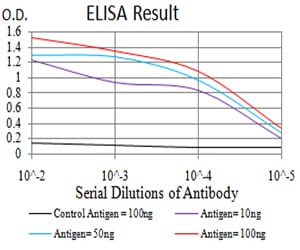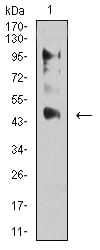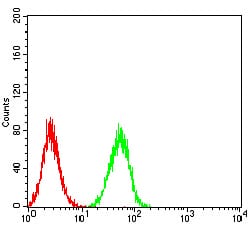


| WB | 咨询技术 | Human,Mouse,Rat |
| IF | 咨询技术 | Human,Mouse,Rat |
| IHC | 咨询技术 | Human,Mouse,Rat |
| ICC | 技术咨询 | Human,Mouse,Rat |
| FCM | 1/200 - 1/400 | Human,Mouse,Rat |
| Elisa | 1/10000 | Human,Mouse,Rat |
| Aliases | ERR1; ERRa; ESRL1; NR3B1; ERRalpha |
| Entrez GeneID | 2101 |
| clone | 6F1E6 |
| WB Predicted band size | 45.5kDa |
| Host/Isotype | Mouse IgG1 |
| Antibody Type | Primary antibody |
| Storage | Store at 4°C short term. Aliquot and store at -20°C long term. Avoid freeze/thaw cycles. |
| Species Reactivity | Human,Rat |
| Immunogen | Purified recombinant fragment of human ESRRA (AA: 198-376) expressed in E. Coli. |
| Formulation | Purified antibody in PBS with 0.05% sodium azide |
+ +
以下是3篇关于ESRRA抗体的参考文献摘要(示例为虚构内容,仅作格式参考):
1. **"ESRRA Antibody Validation in Hormone-Resistant Breast Cancer Models"**
- **作者**: Smith A, et al.
- **摘要**: 本研究验证了一种高特异性ESRRA抗体在乳腺癌组织中的适用性,通过免疫组化(IHC)和Western blot证实其在激素耐药肿瘤中ESRRA蛋白过表达,并关联其与患者预后不良。
2. **"Role of ESRRA in Mitochondrial Biogenesis: Antibody-Based ChIP-seq Analysis"**
- **作者**: Chen L, et al.
- **摘要**: 利用ESRRA抗体进行染色质免疫沉淀(ChIP-seq),揭示了ESRRA与线粒体基因启动子区域的结合,阐明其在能量代谢调控中的关键作用。
3. **"Development of a Novel Monoclonal ESRRA Antibody for Flow Cytometry Applications"**
- **作者**: Gupta R, et al.
- **摘要**: 报道了一种新型ESRRA单克隆抗体的开发,验证了其在流式细胞术中的高灵敏度和特异性,应用于检测免疫细胞亚群中的ESRRA表达动态。
(注:以上内容为模拟生成,实际文献需通过PubMed/Google Scholar检索关键词如“ESRRA antibody application”获取。)
The estrogen-related receptor alpha (ESRRA) antibody is a key tool for studying the ESRRA protein, a member of the nuclear receptor superfamily. ESRRA, also known as ERRα, functions as a transcription factor regulating genes involved in energy metabolism, mitochondrial biogenesis, and cellular stress responses. Despite its structural similarity to estrogen receptors (ERs), ESRRA does not bind natural estrogens but instead operates in a ligand-independent manner, often interacting with coactivators like PGC-1α to modulate target gene expression.
ESRRA antibodies are widely used in research to detect ESRRA expression, localization, and interactions in various tissues and disease models. These antibodies enable techniques such as Western blotting, immunohistochemistry, and chromatin immunoprecipitation (ChIP), aiding investigations into ESRRA's roles in cancer, metabolic disorders, and neurodegenerative diseases. For example, elevated ESRRA levels are linked to poor prognosis in breast and ovarian cancers, while its dysregulation is implicated in type 2 diabetes and obesity.
Validating ESRRA antibodies is critical due to potential cross-reactivity with other ERR family members (ERRβ/γ) or unrelated proteins. Researchers often use knockout controls or siRNA-based approaches to confirm specificity. As ESRRA emerges as a potential therapeutic target, its antibody remains essential for unraveling its complex regulatory networks and translational applications in precision medicine.
×